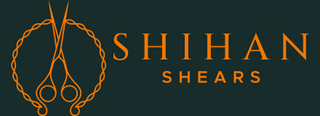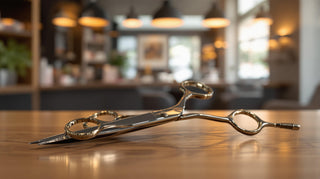Using the right shears is key to achieving clean, precise cuts and keeping your hands comfortable during long sessions. Here’s a quick breakdown of the main points:
-
Types of Shears:
- Straight Shears: For basic cutting, blunt cuts, and point cutting.
- Thinning Shears: Reduce hair bulk and blend layers seamlessly.
- Texturizing Shears: Add movement and volume to hair.
-
Key Features:
- Blade Length: Shorter blades (4.5″–5.5″) for detailed work, longer blades (6.5″–8″) for face-framing and barbering.
- Handle Types: Classic for balance, offset for comfort, crane for advanced ergonomics.
- Material: High-quality stainless steel ensures durability and sharpness.
-
Techniques:
- Blunt, point, and slide cutting for straight shears.
- Blending and weight removal with thinning shears.
- Adding texture and shaping with texturizing shears.
-
Maintenance Tips:
- Clean, dry, and lubricate shears daily.
- Store them in a protective case and check blade tension regularly.
Investing in ergonomic, high-quality shears not only improves your results but also reduces hand fatigue. Whether you’re trimming, thinning, or texturizing, having the right tools ensures precision and client satisfaction.
How To Hold Scissors/Shears & Comb
Straight Shears: Basic Cutting Tools
Straight shears are a must-have for any stylist, delivering clean lines and precise cuts. Designed for accuracy, they easily outperform regular scissors.
Design and Construction
Professional straight shears are crafted to enhance precision and comfort. They typically feature circular finger holes - your ring finger goes in the top hole, and your thumb in the bottom - for better control .
There are three main handle designs, each suited to different cutting styles:
| Handle Type | Ideal For | Features |
|---|---|---|
| Classic | Standard cuts | Balanced weight, aligned finger rings |
| Offset | Long cutting sessions | Reduces wrist strain, ergonomic design |
| Crane | Detailed techniques | Offers superior ergonomic support and control |
Basic Cutting Methods
Thanks to their design, straight shears can handle several essential cutting techniques:
- Blunt Cutting: Perfect for sharp, clean lines in styles like bobs and bangs. Keep tension consistent to avoid uneven edges .
- Point Cutting: Adds texture by cutting into the hair ends at an angle. This technique softens lines and introduces movement .
- Slide Cutting: Ideal for creating seamless layers without harsh lines. Relax your fingers and wrist for better control .
Once you've mastered these techniques, choosing the right shear size can further improve your results.
Picking the Right Shear Size
Using the correct shear size makes cutting more efficient. Most stylists prefer 5.5″ to 6″ shears for general techniques. However, blade size can vary based on the task:
- Short blades (4.5″–5.5″): Great for precise work around facial features.
- Medium blades (5.5″–6″): Ideal for everyday cutting needs.
- Long blades (6.5″–8″): Best for barbering and face-framing cuts .
A simple way to find the right size is to match the blade length to your middle finger and the overall scissor length to your extended palm .
"When choosing the size of a scissor, it is really important to keep in mind the comfort of the scissor." - Caralee, The Scissor Mall
Longer blades provide better visibility for face-framing cuts by keeping the shears further from the client's face . However, be cautious with the blade tips when working near sensitive areas .
Thinning Shears: Reducing Hair Bulk
Understanding Thinning Shears
Thinning shears have one straight blade and one notched blade, allowing them to remove selected strands of hair while keeping the length and shape intact . Unlike regular scissors, they’re specifically designed to thin out thick hair without altering its overall structure.
Typically, thinning shears with 40 teeth can take out around 35–40% of hair bulk . This makes them a great option for creating a more natural look while managing thicker hair. Below, we’ll explore techniques that help blend and reduce hair weight effectively.
Blending and Weight Removal
Stylists use a range of techniques with thinning shears to achieve specific results:
| Technique | Best For | Effect |
|---|---|---|
| Point Cutting | Softening ends | Adds natural texture without harsh layers |
| Twist Cutting | Heavy sections | Reduces bulk while maintaining movement |
| Slide Cutting | Layer transitions | Blends lengths seamlessly |
Focus on mid-lengths and ends when using thinning shears. Avoid cutting too close to the scalp, and always work on dry hair. Use a controlled, gentle motion to ensure smooth, natural blending .
Tooth Count and Results
The number of teeth on thinning shears determines how much hair is removed. Here’s a quick guide:
- Fine to medium hair: Shears with 35-40 teeth help prevent over-thinning .
- Thick hair: Opt for 25-30 teeth to effectively reduce bulk .
- Double-sided shears: These create a softer, more subtle finish .
For best results, it’s useful to have different thinning shears with varying tooth counts. Higher tooth counts remove less hair, ideal for smooth transitions, while lower counts are better for tackling more bulk .
After each pass, comb through the hair to check your progress and ensure weight is distributed evenly . If you’re working with curly hair, consider using texturizing shears to avoid causing frizz .
sbb-itb-a50b05d
Texturizing Shears: Creating Hair Movement
Texturizing shears go beyond the basics of cutting and thinning by adding movement and volume to hairstyles. While thinning shears are great for reducing bulk, texturizing shears are all about shaping and creating flow.
Thinning vs. Texturizing Shears
The difference between thinning and texturizing shears lies in their design and purpose. Texturizing shears have 5–14 widely spaced teeth, making them perfect for shaggy or layered cuts. On the other hand, thinning shears have 28–40 closely spaced teeth, which are ideal for blending and softening lines.
"Texture shears have wider teeth and are designed to create texture in the hair", explains Jun Oh.
Techniques for Adding Texture
Once you understand the difference, you can use texturizing shears effectively by trying these techniques. Always work with dry hair to see how it naturally falls:
- Point Cutting: Cut about one inch from the ends with a right-to-left motion for a natural, textured look.
- Internal Cutting: Focus on mid-lengths to create layers that add depth and movement.
- Twist Cutting: Twist sections of hair before cutting to create uneven lengths and a dynamic texture, especially useful for thick hair.
Adapting to Different Hair Types
The way you use texturizing shears depends on the hair type you're working with:
- Fine Hair: Focus on the ends and use a gentle approach to add light texture and volume.
- Thick Hair: Use wider-toothed shears for internal layers that reduce bulk but keep the fullness.
- Curly Hair: Stick to the ends to maintain the natural curl pattern. Avoid over-texturizing to prevent frizz, and consider chunking shears for more controlled results.
For the best outcome, always shape the haircut first, then add texture as the final touch.
Buying and Maintaining Shears
When it comes to achieving precision, having the right tools and taking care of them properly is just as important as mastering your technique.
Daily Shear Care
Keeping your shears clean is a must. After each use, rinse them with warm, soapy water, especially after sanitizing. Always wipe away from the cutting edge to avoid damaging the blades. Skip Barbicide - it can harm the blade integrity .
Here's a quick checklist for daily care:
- Dry thoroughly to prevent rust.
- Lubricate weekly at the pivot screw.
- Store in a protective case with a moisture-absorbing lining.
- Check tension daily for optimal performance.
- Sharpen only when needed - if the blades pull hair instead of cutting cleanly, it's time.
Regular cleaning and lubrication not only keep your shears in top shape but also help reduce hand strain during use.
Preventing Hand Strain
Hand strain is a common issue for professionals, and preventing it is essential for long-term performance. Repetitive stress injuries cost the industry a staggering $20 billion annually in workers' compensation . Choosing tools with ergonomic designs can make a big difference:
| Handle Type | Benefits | Ideal For |
|---|---|---|
| Crane | Minimizes wrist bending, most ergonomic | Long cutting sessions |
| Offset | Offers moderate ergonomics | Straight-line cutting |
| Classic | Simple design | Point cutting |
"These are like a pair of Louis Vuittons, they may take a week to get used to, but after that you're performing at a higher level." – Sam Villa, Founder of Sam Villa Professional
Professional Shear Options
The right tools can take your work to the next level. Here are a few key factors to consider when choosing professional shears:
- Length Matters: 5.5-inch shears are ideal for detailed work, while 6-inch or longer shears offer versatility .
- Material Quality: Opt for high-grade Japanese steel for durability and long-lasting sharpness.
- Blade Design: Convex edges require less cutting force compared to beveled blades, making them a favorite among professionals .
For top-tier options, check out Shihan Shears' Legacy Hair Shears Set ($269.00). This set includes both cutting and thinning shears made from premium ATS-314 steel. Designed with ergonomics in mind, these shears also come with a lifetime warranty, ensuring they remain a reliable part of your toolkit.
Conclusion: Using the Right Shears
Choosing the right shears can make all the difference in achieving precise, high-quality cuts. Each type of shear serves a specific purpose, and matching them to the right technique is key. For example, 5.5-inch shears are perfect for detailed face-framing, 6-inch shears work well for general layering, and 7-inch shears are ideal for blending long hair seamlessly .
Here’s a quick look at some essential pairings:
| Technique | Recommended Shear | Best Results |
|---|---|---|
| Point Cutting | 5.5" Classic Handle | Soft, natural texture |
| Slide Cutting | 6.5" Convex Edge | Smooth, flowing layers |
The blade edge also plays a crucial role. Convex edges deliver sharp, clean transitions, making them great for fine hair, while beveled blades provide better control for thicker or curly hair .
When working with different hair textures, the right tools can enhance both results and efficiency. Fine hair pairs well with lightweight, sharp shears, while thick hair demands sturdier tools with ergonomic handles. Choosing the appropriate shears not only improves performance and client satisfaction but also helps reduce stylist fatigue during long sessions .

